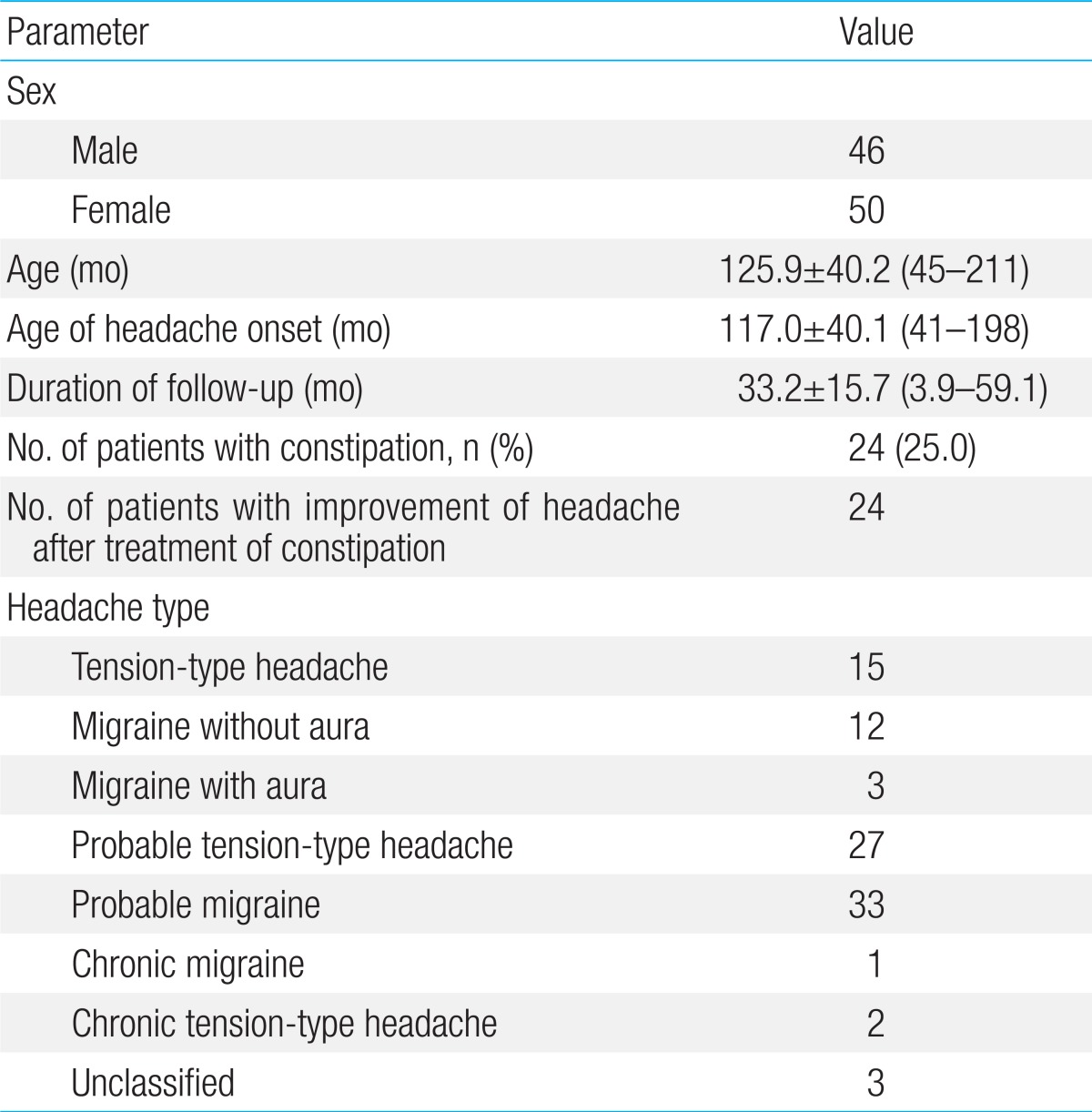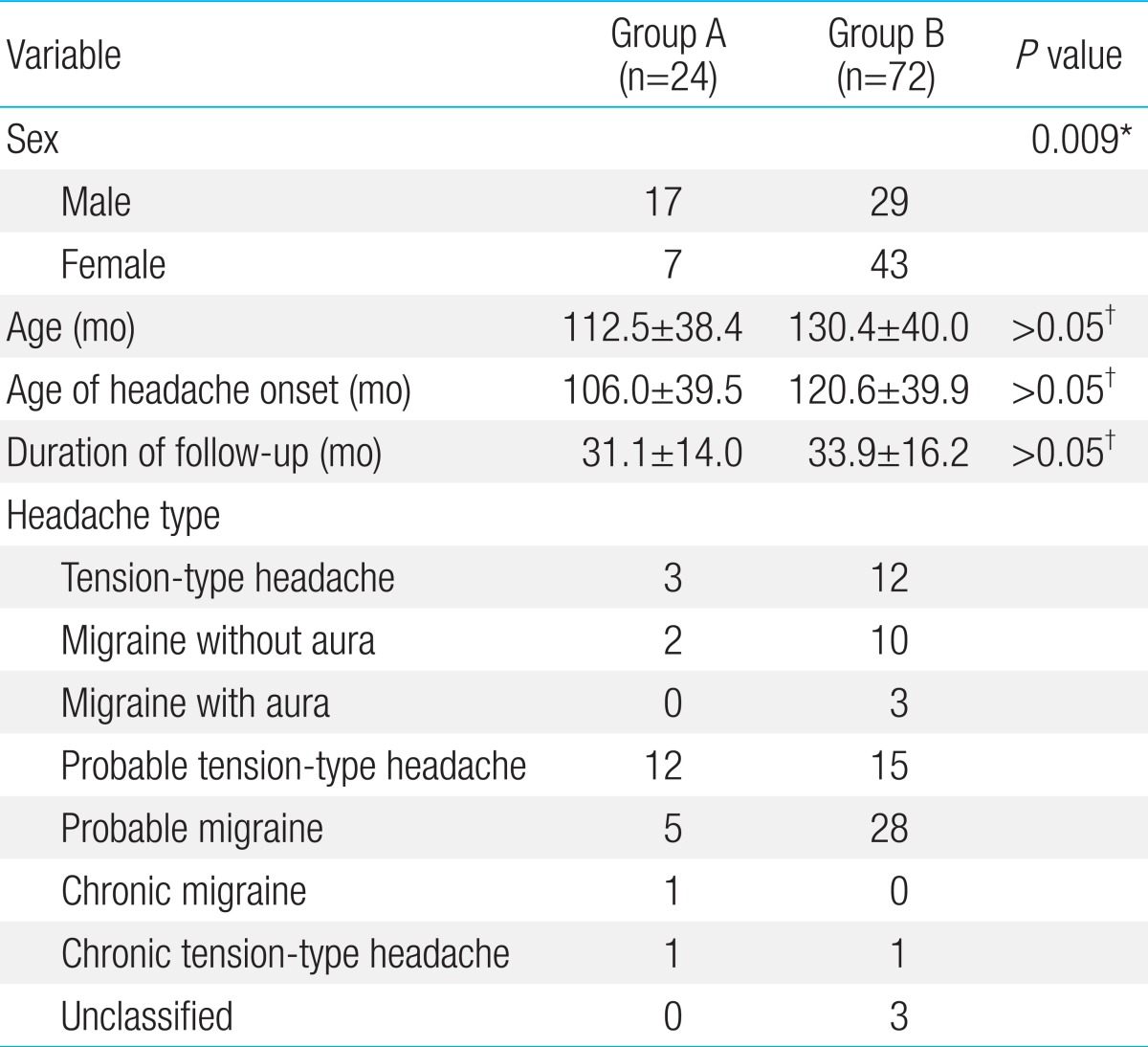The relationship between primary headache and constipation in children and adolescents
Article information
Abstract
Purpose
Many patients presenting with headache also complain of constipation; the relationship between these two symptoms has not been explored in detail. The aim of this study was to investigate the association between primary headache and constipation.
Methods
This retrospective study included all children who attended the Inje University Sanggye Paik Hospital complaining of headache, and who had been followed up for at least 100 days. Patients were divided into 2 groups: group A, in whom the headache improved after treatment for constipation, and group B, in whom headache was not associated with constipation.
Results
Of the 96 patients with primary headache, 24 (25.0%) also had constipation (group A). All 24 received treatment for constipation. Follow-up revealed an improvement in both headache and constipation in all patients. Group B contained the remaining 72 children. Comparison of groups A and B indicated a significant difference in sex ratio (P=0.009, chi-square test). Patients with probable tension-type headache were more likely to be in Group A (P=0.006, chi-square test).
Conclusion
Resolution of constipation improves headache in many patients diagnosed with primary headache, especially those with probable tension-type headache. We suggest that either constipation plays a key role in triggering headache, or that both constipation and headache share a common pathophysiology.
Introduction
Headaches, while often alarming for parents, are very common during childhood and adolescence. The prevalence of headache among school children was 29.1% in South Korea1). Constipation also commonly affects children and adolescents, with the prevalence ratio from 0.7% to 29.6% globally2,3,4,5,6).
The mechanisms underlying primary headache are unclear and are artificially classified using diagnostic criteria7). Severe and frequent primary headache, especially migraine and tension-type headache, is treated by preventive management; however, some patients' symptoms are intractable8). Another problem is that, unlike adults, many children with headache cannot describe their symptoms in detail. Therefore, it is possible that many children and adolescents have secondary headache caused by disease, such as irritable bowel syndrome (IBS), not involving organic problems in the brain, who are misdiagnosed with primary headache.
Many patients with headache also have constipation. Of course this may simply reflect the fact that both headache and constipation are common disorders. But these two disorders apparently share many similarities. Although the studies about relationship between headache, especially migraine and IBS are reported9,10), there is no report about direct comparison between primary headache and constipation in children.
However, we have observed that headache in some patients improves after resolution of constipation. Therefore, we studied the relationship between headache and constipation in children and adolescents and discussed the mechanisms.
Materials and methods
All children (n=105) who attended the Inje University Sanggye Paik Hospital in Korea between June 2009 and April 2013 because of a headache were investigated. Nine patients were excluded as they were diagnosed with secondary headache (i.e., sinusitis, organic abnormalities of the brain or psychiatric problem), or because they were followed up for less than 100 days. The final study population included 96 patients (46 males and 50 females) aged between 3 years and 9 months and 17 years and 7 months who were diagnosed with primary headache. Patients were followed up for at least 100 days between June 2009 and April 2013. A questionnaire was completed for each patient to gather information about the headache, their general and medical history, and their defecation habit. A follow-up headache diary was also completed. All patients underwent neurological and general examinations as well as other types of investigation (e.g., neurological imaging and electroencephalography) when necessary. Headache was diagnosed according to the criteria of the International Classification of Headache Disorders (2nd edition revised)7). Medical definitions of constipation vary. Some are specific, based on the interval between defecations, with three days or twice weekly as the upper limit of normality. Others are vague, such as infrequent or incomplete bowl movement11). We defined constipation by Rome III Criteria12). Criteria of improvement of headache after treatment of constipation is symptom improvement compared to the previous existence by interview. In our study, patients with constipation were investigated through questionnaires. The kinds of treatments of constipation are medication (lactulose, magnesium hydroxide, macrogol) or bio-behavioral therapies. Patients were categorized according to the response of their headache to treatment of their constipation: group A comprised patients whose headache improved after treatment for constipation, while group B comprised patients whose headache was not associated with constipation.
Data were analyzed using SPSS ver. 12.1 (SPSS Inc., Chicago, IL, USA). Differences between groups A and B were evaluated using a two-tailed chi-square test, Student t-test or Mann-Whitney test. P values <0.05 were considered statistically significant.
Results
Detailed characteristics of the patients are listed in Table 1. Of the 96 patients with primary headache, 46 (47.9%) were male and 50 (52.1%) were female. The mean age (±standard deviation) of the participants was 125.9±40.2 months (range, 45-211 months) and the mean age at onset of headache was 117.0±40.1 months (range, 41-198 months). The median duration of follow-up was 33.2±15.7 months (range, 3.9-59.1 months). Fifteen children had tension-type headache (15.6%), 12 had migraine without aura (12.5%), 3 had migraine with aura (3.1%), 27 had probable tension-type headache (28.1%), 33 had probable migraine (34.4%), 1 had chronic migraine (1.0%), 2 had chronic tension-type headache (2.1%), and 3 had unclassified headache (3.1%).
Of all patients examined in the study, 24 (25.0%, 24/96) had constipation. Twenty-one of these patients had been treated with medication and bio-behavioral therapy. Two patients had been treated with only bio-behavioral therapy. One patient had been treated with medication. All of 24 patients' symptoms had been improved. Table 2 shows a comparison between groups A and B. Group A contained 24 children (25.0%, 24/96) whose headache improved after treatment for constipation. Group B contained 72 children (75.0%, 72/96) whose headache was not associated with constipation. Groups A and B differed in terms of sex ratio (P=0.009, chi-square test), but not in terms of mean age, age of onset of headache, or duration of follow-up (P>0.05, Student t-test). Patients with probable tension-type headache were more likely to be in group A (P=0.006, chi-square test) (Table 3).
Discussion
Both headache and constipation are common symptoms that cause significant pain and discomfort, resulting in reduced function and diminished quality of life. In addition, many patients with headache have constipation. Our results also showed that the prevalence of constipation in patients with a diagnosis of primary headache was 25.0% (24/96), which is greater than the prevalence in the general population. Moreover, headache symptoms improved in all patients after treatment for constipation or did not receive treatment, indicating a possible link between the two conditions.
Although IBS definition remains unclear, it is characterized by chronic and recurrent abdominal pain/discomfort associated with disturbed defecation12). Of IBS, constipation-predominant IBS (IBS-C) is similar to constipation in our study. IBS-C and functional constipation are two exactly distinct function gastrointestinal diseases because the latter lacks obvious abdominal pain, but their difference was not easily to describe in child and overlapping was observed in two conditions. Many researches indicated that 25%-50% of IBS subjects had either migraine or headache, whereas those of controls were only 4%-19%9,13,14). IBS and headache including migraine and tension-type headache often have a lot of comorbidities, such as fibromyalgia, chronic fatigue syndrome, panic disorder, depressive disorder, etc.9). However, our result showed that probable tension-type headache were more likely to be related with constipation. The reasons are that children are unable to describe their headache (duration, character, aura, and associated symptoms) in detail, or many patients with tension-type headache or probable tension-type headache can be diagnosed as migraine later and mild migraine patients can also have tension-type headache15).
Headache and IBS or constipation share certain aspects of pathophysiology. First, serotonin (5-hydroxytryptamine), which is related to both migraine and constipation16), is increased in the gastrointestinal mucosa of children with constipation17). Second, the prevalence of psychogenic problems, including depressive disorders, is higher in patients with both headache and constipation18,19,20). Third, constipation is related with stress, dehydration, less fluid intake and decreases appetite. These factors may cause headache. Valsalva maneuvers such as straining at stools trigger headache21). Forth, visceral hypersensitivity was known leading to IBS and upward to central nervous system (CNS)22) and hypersensitivity to some stimuli leading to activation and sensitization of trigermino-vascular pain pathway and the resulting headache in headache, especially migraine patients23). Other common aspect is that mitochondrial dysfunction and mitochondrial DNA sequence variants were addressed closely to gut dysfunction and migraine10).
Recent research indicates that bidirectional brain-gut interactions take part in regulating gut function in both healthy and diseased states24). The role of the CNS in modulating various functions of gastrointestinal tract, including motility, secretion, blood flow, and gut-associated immune function in response to psychological or physical stressors, is well established25). Indeed, signaling between the gut and CNS has been researched extensively; such as, the effect of mucosal inflammation on nociceptive responses26). We propose that headache and constipation may be a manifestation of such bidirectional brain-gut interactions.
In conclusion, this retrospective study suggests that there may be a relationship between headache and constipation. Therefore, we advise clinicians to include questions about gastrointestinal function when taking a history from patients complaining of headache and to screen for psychiatric comorbidities.
Notes
No potential conflict of interest relevant to this article was reported.


